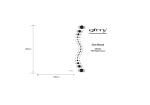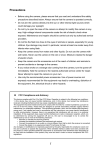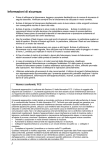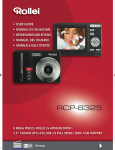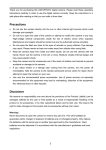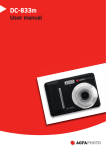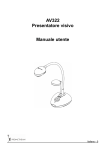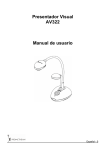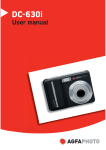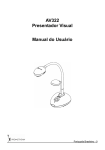Download Genius G-Shot P850
Transcript
English WEEE Warning Message Symbol for Separate Collection in European Countries This symbol indicates that this product is to be collected separately. The following apply only to users in European countries: z This product is designated for separate collection at an appropriate collection point. Do not dispose of as household waste. z For more information, contact the retailer or the local authorities in charge of waste management. FCC STATEMENT This device complies with Part 15 of the FCC Rules. Operation is subject to the following two conditions: (1). This device may not cause harmful interference, and (2). This device must accept any interference received, including interference that may cause undesired operation. Note: This equipment has been tested and found to comply with the limits for Class B digital devices, pursuant to Part 15 of the FCC rules. These limits are designed to provide reasonable protection against harmful interference in a residential installation. This equipment generates uses and can radiate radio frequency energy and, if not installed and used in accordance with the instructions, may cause harmful interference to radio communications. However, there is no guarantee that interference will not occur in a particular installation. If this equipment does cause harmful interference to radio or television reception, which can be determined by turning the equipment off and on, the user is encouraged to try to correct the interference by one or more of the following measures: Reorient or relocate the receiving antenna Increase the separation between the equipment and receiver Connect the equipment into an outlet on a circuit different from that to which the receiver is connected -1- English Use of shielded cable is required to comply with Class B limits in Subpart B of Part 15 of the FCC rules. Do not make any changes or modifications to the equipment unless otherwise specified in the manual. If such changes or modifications should be made, you could be required to stop operation of the equipment. Product Information 1. Product design and specifications are subject to change without notice. This 2. 3. 4. 5. includes primary product specifications, software, software drivers, and user’s manual. This User Manual is a general reference guide for the product. The product and accessories that come with your camera may be different from those described in this manual. This is due to the fact that different retailers often specify slightly different product inclusions and accessories to suit their market requirements, customer demographics, and geographical preferences. Products very often vary between retailers especially with accessories such as batteries, memory cards, cables, carrying cases/pouches, and language support. Occasionally a retailer will specify a unique product color, appearance, and internal memory capacity. Contact your dealer for precise product definition and included accessories. The illustrations in this manual are for the purpose of explanation and may differ from the actual design of your camera. The manufacturer assumes no liability for any errors or discrepancies in this user manual. For driver updates, you can check the “Download” section of our website, www.geniusnet.com SAFETY INSTRUCTIONS Read and understand all Warnings and Cautions before using this product. Warnings If foreign objects or water have entered the camera, turn the power OFF and remove the batteries. Continued use in this state might cause fire or electric shock. Consult the store of purchase. If the camera has fallen or its case has been damaged, turn the power OFF and remove the batteries. Continued use in this state might cause fire or electric shock. Consult the store of purchase -2- English Do not disassemble, change or repair the camera. This might cause fire or electric shock. For repair or internal inspection, ask the store of purchase. Do not use the camera in areas near water. This might cause fire or electric shock. Take special care during rain, snow, on the beach, or near the shore. Do not place the camera on inclined or unstable surfaces. This might cause the camera to fall or tilt over, causing injury. Keep the batteries out of the reach of children. Swallowing batteries might cause poisoning. If the battery is accidentally swallowed, immediately consult a physician. Do not use the camera while you are walking, driving or riding a motorcycle. This might cause you to fall over or result in traffic accident. Cautions Insert the batteries paying careful attention to the polarity (+ or –) of the terminals. Inserting the batteries with its polarities inverted might cause fire and injury, or damage to the surrounding areas due to the battery rupturing or leaking. Do not fire the flash close to anyone’s eyes. This might cause damage to the person’s eyesight. Do not subject the LCD monitor to impact. This might damage the glass on the screen or cause the internal fluid to leak. If the internal fluid enters your eyes or comes into contact with your body or clothes, rinse with fresh water. If the internal fluid has entered your eyes, consult a physician to receive treatment. A camera is a precision instrument. Do not drop it, strike it or use excessive force when handling the camera. This might cause damage to the camera. Do not use the camera in humid, steamy, smoky, or dusty places. This might cause fire or electric shock. Do not remove the battery immediately after long period of continuous use. The battery becomes hot during use. Touching a hot battery might cause burns. Do not wrap the camera or place it in cloth or blankets. This might cause heat to build up and deform the case, resulting in fire. Use the camera in a well-ventilated place. Do not leave the camera in places where the temperature may rise significantly, such as inside a car. This might adversely affect the case or the parts inside, resulting in fire. -3- English Before you move the camera, disconnect cords and cables. Failure to do this might damage cords and cables, resulting in fire and electric shock. Notes on Battery Usage When you use the battery, carefully read and strictly observe the Safety Instructions and the notes described below: Different battery types and surrounding temperatures may affect the battery performance. Avoid using batteries in extremely cold environments as low temperatures can shorten the battery life and reduce camera performance. The battery may feel warm when using the camera for an extended period of time or using the flash continuously. This is normal and not a malfunction. The digital camera may feel warm when being used continuously or for an extended period of time. This is normal and not a malfunction. If you will not be using the batteries for an extended period of time, remove them from the camera to prevent leakage or corrosion. Always keep the terminals in a clean state. Never use manganese batteries. Risk of explosion if battery is replaced by an incorrect type. Dispose of used batteries according to the instructions. -4- English CONTENTS INTRODUCTION _________________________________________________________ 8 PACKAGE CONTENTS _____________________________________ 8 GETTING TO KNOW YOUR CAMERA _______________________________________ 9 FRONT VIEW ___________________________________________ 9 REAR VIEW ____________________________________________ 9 TOP VIEW ____________________________________________ 10 RIGHT VIEW __________________________________________ 10 BOTTOM VIEW ________________________________________ 10 INSERTING THE BATTERY ________________________________ 11 CHARGING THE BATTERY PACK ____________________________ 12 INSERT THE MEMORY CARD ______________________________ 12 SETTING THE DISPLAY LANGUAGE / DATE & TIME _____________ 13 SETTING THE DATE & TIME ______________________________ 13 LCD MONITOR INFORMATION ____________________________ 14 REC Mode __________________________________________ 14 PLAYBACK MODE ____________________________________ 15 GETTING STARTED _____________________________________________________ 16 TURNING THE POWER ON AND OFF_________________________ 16 POWER SAVING FUNCTION _______________________________ 16 CHANGING THE MODE __________________________________ 17 Switching between REC mode and PLAYBACK mode ________ 17 Selecting the REC mode _______________________________ 17 Selecting the ASM mode _______________________________ 18 USING THE MENUS _____________________________________ 19 REC menu __________________________________________ 19 REC menu list (Still Image) _____________________________ 19 REC menu list (Movie) ________________________________ 20 Setup menu__________________________________________ 20 BASIC RECORDING_____________________________________________________ 22 RECORDING STILL IMAGES _______________________________ 22 Using the Q mode ____________________________________ 22 Setting Image Size and Quality __________________________ 22 Resolution Values_____________________________________ 22 Quality Values _______________________________________ 23 Using the Zoom Function ______________________________ 23 -5- English Using the Flash ______________________________________ 24 Using the Macro _____________________________________ 25 Using the Self-timer & Burst ____________________________ 25 Using the Aperture Priority _____________________________ 26 Using the Shutter Priority ______________________________ 26 Using the Manual Exposure ____________________________ 26 RECORDING MOVIE CLIPS _______________________________ 27 Movie Size and Frame Rate_____________________________ 27 YOUTUBE MODE ______________________________________ 28 Recording Audio Clips_________________________________ 28 Playing Back Audio Clips ______________________________ 28 Recording a Voice Memo _______________________________ 29 Playing Back a Voice Memo ____________________________ 29 OTHER RECORDING FUNCTIONS _________________________________________ 30 SETTING THE METERING _________________________________ 30 Setting the White Balance ______________________________ 30 Setting the ISO_______________________________________ 31 Setting the Exposure __________________________________ 31 Setting the AEB ______________________________________ 31 Setting the Highlight __________________________________ 31 Setting the Sharpness__________________________________ 32 Setting the Photo Edit _________________________________ 32 Setting Date Stamp ___________________________________ 32 Setting Stabilizer _____________________________________ 32 Setting Face tracking__________________________________ 33 Setting Photo Frame __________________________________ 33 Setting AF Lamp _____________________________________ 33 PLAYBACK ____________________________________________________________ 34 PLAYING BACK IMAGES _________________________________ 34 Playing Back Movie Clips ______________________________ 34 Magnifying and Trimming Still Images ____________________ 34 Viewing in Thumbnail _________________________________ 35 Playing a Slide Show __________________________________ 35 DELETING FILES _______________________________________ 36 Deleting Multiple Files ________________________________ 36 Deleting All Files_____________________________________ 37 -6- English Protecting a Single File ________________________________ 37 Protecting All Files ___________________________________ 37 Protecting Multiple Files _______________________________ 38 EDITING IMAGES _______________________________________ 38 Rotating Still Images __________________________________ 38 Changing the Image Size _______________________________ 38 Changing the Image with Effects _________________________ 39 Choosing the Image with Photo Frame ____________________ 39 Copying the Files_____________________________________ 39 Setting the DPOF ____________________________________ 40 MAKING CONNECTIONS_________________________________________________ 41 CONNECTING THE CAMERA TO A TV________________________ 41 CONNECTING THE CAMERA TO A PC ________________________ 41 Using the Card Reader ________________________________ 41 Connecting the Camera to a Computer with the USB Cable____ 42 POSSIBLE NUMBER OF SHOTS (STILL IMAGE) __________________ 42 TROUBLESHOOTING ___________________________________________________ 43 SPECIFICTIONS ________________________________________________________ 44 -7- English Introduction Thank you for purchasing this new digital still camera! Capturing high-quality digital images is fast and easy with this state-of-the-art smart camera. Equipped with an 8.0-megapixel sensor, this camera is capable of capturing images with a resolution of up to 3264 x 2448 pixels. Other features provided by the camera include the following: True 8.0 Mega Pixel CCD 2.7” TFT LTPS LCD monitor 3X Optical zoom 4X Digital zoom Face Tracking Smile Detection Anti-Shaking High ISO value up to 3200 SD memory card can support up to 8 GB Package contents Carefully unpack your kit box and ensure that you have the following items. Digital Camera CD driver includes: - Pesto! Mr. Photo - Quick Time - Adobe Reader - Multi-Language User’s Manual USB cable TV OUT cable Rechargeable Lithium-ion Battery Battery Charger Adaptor Quick Guide Pouch Strap Warranty Card -8- English GETTING TO KNOW YOUR CAMERA Front View 1. 2. 3. 4. AF Lamp / Self-timer Lamp Flash Lens Microphone Rear View 5. Operation Lamp 6. Zoom Button y Thumbnail y Playback Zoom 7. Playback Button 8. Menu Button 9. Mode Button 10. ASM Button y Delete Button 11. LCD Monitor 12. Flash Button 13. SET/DISP Button 14. Macro Button -9- English Top View 15. Shutter Button 16. Power Button Right View 17. Strap Ring 18. USB/AV Terminal Bottom View 19. Speaker 20. Tripod Socket 21. Battery Cover -10- English Inserting the Battery The camera is powered by a rechargeable lithium-ion battery (Li-Ion 820 mAh). 1. Open the battery cover. Slide the battery cover in the direction indicated by the arrow. 2. Insert the battery. Install the battery with the terminal facing inside the camera. 3. Close the battery cover. NOTE z A low battery indicator appears on the LCD screen when the batteries are nearly exhausted. Battery should be replaced promptly when the low battery indicator appears. -11- English Charging the battery Pack The battery is not charged so you should charge it before using the camera. 1. Place the battery pack in the charger with the label facing up. 2. Connect the AC adaptor to the charger, and then plug it into a power outlet. The charger lamp lights red and battery charging begins. When charging is completed, the lamp becomes green. Insert the memory Card You can use SD Card with this digital camera. The memory card slot is located beneath the battery cover, adjacent to the battery compartment. 1. Open the battery cover. Slide the battery cover in the direction indicated by the arrow. 2. Insert the card. Insert the card with the label facing up and the arrow pointing in. -12- English 3. Close the battery cover. NOTE z This camera is equipped with internal memory. If the memory card is not inserted in the camera, all images and movie clips recorded by the camera will be stored in the internal memory. If the memory card is inserted, images and movie clips are stored on the memory card. z It may cause damage to the card if removed while the camera is on. Setting the Display Language / Date & Time 1. Turn the power on, and set the camera to the Setup Menu Language]. 2. Select [ Press or to select [LANGUAGE] then press or the SET button to launch the submenu 3. Select a language. Press or to select a language and the SET button to apply the setting. 4. Press the MENU button to close the menu. Setting the Date & Time 1. Turn the power on, and set the camera to the Setup Menu 2. Select [ Date & Time]. Press or to select [Date & Time] then press or the SET button to launch the submenu 4. Set date and time. Press or to change the value of the cursor located. Press or to move the cursor between settings. 4. Apply the setting. After adjusting the settings, press the SET or the MENU button to apply the setting. NOTE z If the battery is removed for longer than 48 hours, the Date and Time will need to be re-set. -13- English LCD Monitor Information REC Mode 1 2 3 4 5 6 7 8 9 10 11 12 25 Recording mode Flash Macro Self-timer / Burst Zoom indicator Shots remaining Battery Storage media Stabilizer Metering ISO Histogram AF Lamp 13 14 15 16 17 18 19 20 21 22 23 24 -14- White balance Shutter speed Shake warning Aperture value Face tracking Exposure Focus area Date stamp AEB Sharpness Quality Resolution English PLAYBACK mode 1 2 3 4 5 6 Playback mode Protect Voice memo File number / Total Battery Storage media 7 8 9 10 11 12 Recording info Histogram Captured date & time Voice memo control DPOF Resolution NOTE z Some information may not display correctly if you display images captured by another camera model. -15- English GETTING STARTED Turning the Power On and Off 1. Press the POWER button (n) to turn on the camera in the REC mode. The power turns on, the lens extends and the LED lights in green. Press the PLAYBACK button (o) to turn on the camera in the PLAYBACK mode. The power turns on, and an image displays on the LCD monitor (p) 2. Press the POWER button (n) again to turn the power off. The power turns off, the lens retracts and the LED turns off. Power Saving Function For saving the battery power, the LCD monitor automatically turns off one minute after the last control accessed (factory-preset setting). Press any button other than the power button to turn on the LCD monitor. You can change the power save setting in Setup menu. After the power saving function has been active for one minute, the power will turn off completely. Press the POWER (n) or the PLAYBACK (o) button to restore the power. The power save feature will not activate in the following situation: Recording movie clips or audio files Playing movie clips or audio files Playing the slideshow Connecting the camera to a computer or printer with the USB cable -16- English Changing the Mode You can record images and voices in the REC mode. And using the PLAYBACK mode to replay, delete, or edit images on the LCD monitor. Switching between REC mode and PLAYBACK mode In REC mode, press the PLAYBACK button (n) to switch to the PLAY mode. In PLAY mode, press the PLAYBACK (n) or the MODE (o) button to switch to the REC mode. Selecting the REC mode 1. Set the camera to the REC mode. 2. Launch the mode palette. Press the MODE button (o) to show the scene mode palette. 3. Select a mode. Use the four-way control to select a desired mode and press the SET button to confirm the setting. Display Title Program Movie Voice REC Q Mode Portrait Landscape Sunset Backlight Smile Capture Kids Night Scene Description The camera makes settings suitable for the shooting conditions. For recording movie clips. For recording audio. Allows beginners to take pictures easily. Blurring the background to focus on the subject. Used for the wide scenic views. Enhance the red hue for recording sunset images. Shooting the image of backlight object by changing metering. Capture the most brilliant smile of characters. Take a still image to capture moving kids. Shooting the subject while keeping the background night scenery. -17- English Display Title Fireworks Snow Sports Party Candlelight Night Portrait Soft Skin Soft Flowing Water Auction Food Building Text Description Slow shutter speed to take fireworks exploding. For beach or snow scenes. Take still pictures in high speed motion. For wedding or indoor parties. Capture the effects of candle light. Use to take portrait pictures when the background is darker. Enhance the skin tone so that the facial skin appears smooth. Can take pictures with effects as smooth as silk. Records small-size images that are perfect for auction notices. Higher saturation makes food more appetizing. Enhance the edges of the subject. Enhance the black & white contrast. Selecting the ASM mode 1. Set the camera to the REC mode. It cannot be switched to ASM mode while in Movie or Voice REC mode. 2. Launch the ASM mode. Press the ASM button (n) to toggle switch between Aperture Priority, Shutter Priority, Manual Exposure mode. 3. Exit the ASM mode. Use the ASM jog wheel or the display mode button select the scene then a recording mode. -18- English Using the Menus When a menu is displayed, the four-way control and the SET button are used to make the desired settings. REC menu 1. Turn the power on, and set the camera to the REC mode 2. Open the REC menu. Press the MENU button (n) to display the menu. 3. Select an item. Press or (o) to select a menu item. 4. Change the setting. Press or (o) to change the setting. 5. Press the MENU (n) or the SET (o) button to save the settings and close the menu. REC menu list (Still Image) Menu Item Available Setting Resolution / / Quality / / Metering / / White Balance / / / / Exposure Auto / / / / / / Auto / ISO50 / ISO100 / ISO200 / ISO400 / ISO800 / ISO1600/ ISO 3200 ... Drive Mode Off / / / AEB Highlight Off / Off / / / Sharpness Effect Date Stamp Stabilizer Face Tracking Photo Frame Digital Zoom AF Lamp / / Off / B&W / Sepia / Negative / Red / Green / Blue Off / Date / Date & Time Off / On Off / On Off / Frame 1 ~ 10 Off / On Auto / Off ISO -19- / English REC menu list (Movie) Menu Item Movie Size Metering White Balance Available Setting / / / / Auto / / /`/ / / / Setup menu 1. Turn the power on, and set the camera to the REC or PLAYBACK mode. 2. Press the MENU button (n) to open the REC or PLAYBACK menu. The menu displays depends on whether you are in the REC mode or the PLAYBACK mode. 3. Open the Setup menu. Press the four-way control (o) to select SETUP ( ) and then press the SET (o) button to display the Setup menu. 4. Select an item. Press or (o) to select a menu item and or the SET (o) button to launch then press the submenu. 5. Change the setting. Press or (o) to select an option and press or the SET (o) button to apply the setting. 6. Press the MENU (n) button to close the menu. Menu Item Sounds Auto Review Power Save Functions [Shutter]: [Start-up]: [Beep]: [Volume]: Sets the shutter sound on and off. Sets a type of the start-up sound. Sets the operation sound on and off. Adjusts the volume of the shutter sound, start-up sound, beep and playback sound. [Off]: The captured image will not automatically display after shooing. [1 sec.]: The captured image will display for one second after shooting. [3 sec.]: The captured image will display for three seconds after shooting. [5 sec.]: The captured image will display for five seconds after shooting. [One min.] / [three min.] / [five min.]: For power consumption, the camera is turned off automatically for a period of time. The power save feature will not activate in some situation. -20- English Menu Item Functions Date & Time Sets the date & time. Select a language for the display from the following 21 languages: [English]: English [Deutsch]: German [Italiano]: Italian [Nederlands]: Dutch [Magyar]: Hungarian [Türk]: Turkish [Svenska]: Swedish [Rumänisch]:Romanian [ไ ท ย ]:Thai [한국어]: Korean Language File No. TV Out USB S.Image Format Reset All menus and other information [Español]: Spanish [Français]: French [Português]:Portuguese [Čestina]: Czech [Polski]: Polish [Русский]: Russian [Ελληνικά]: Greek []ﻋ ﺮﺑﻲ: Arabic [日本語]: Japanese [简体中文]: S. Chinese [繁體中文]:T. Chinese Use this function if the camera experiences a “Folder cannot be created” error or if you want to restart numbering. For example, after erasing all files. [Series]: Store the latest used file number no matter- if deleting files or inserting a new memory card. [Reset]: Reset file numbering each time the memory card is changed. Resetting the file number is useful for avoiding file name duplication when images are downloaded to a computer. You can review images on a television with the AV cable. TV Out should be set to either NTSC or PAL depending on your region. [NTSC]: America, Japan and others [PAL]: Europe, Oceania and others [Computer] / [Printer]: Sets the USB mode to connect the camera with a printer or computer. Sets a recorded image as the start-up image. To erase all data stored in the memory card if you are using a card, or all data stored in the internal memory if there is no card inserted. A “BUSY...PLEASE WAIT” message displays and the memory card is starting to format. A “COMPLETED” message displays when finish formatting. All data will be deleted including protected files. Be sure to download important files to your computer before formatting. Resets the entire menu and button operation settings to default. The following settings do not change after Reset All: Date & Time setting Language setting TV out setting -21- English Basic Recording Recording Still Images 1. Press the Power button on, and set the camera to the REC mode. 2. Compose the subject on the monitor. Aim the focus area (n) to the subject that you want to take. 3. Half press the shutter button to focus the image. The focus area (n) becomes green while in focus, then shutter speed (o), aperture value (p) and ISO value (q) are displayed. If the shutter speed is slow or the possibility that the image may be blurred, the shake warning icon may appear on the LCD monitor. To avoid this, use a tripod to stabilize the camera when recording images. 4. Take a picture. Make sure that your fingers or the wrist strap does not block the lens. Using the Q mode The Q mode provides a simplified camera interface. Larger icons and fewer controls make it easier to take pictures anytime, especially for the beginners and elder users. Setting Image Size and Quality You can select lower image resolution and quality to decrease the image size to capture more images. Choose a suitable setting according to the desired image quality and purpose. Resolution Values Image Size 3264 x 2448 3264 x 2176 3264 x 1840 2816 x 2112 2272 x 1704 1600 x 1200 640x480 Print Size Printing larger than A4-size. Printing to postcards or attaching to e-mail. -22- Larger Smaller English Quality Values Compression Purpose Super Fine Shoot higher quality images. Fine Shoot fine quality images. Normal Shoot for normal more images. Higher Quality Lower Quality Using the Zoom Function Your camera has a combination of optical and digital zoom functions that allows you to zoom in on far away subjects or zoom out for a wide angle shot. The optical zoom is achieved by mechanically adjusting the lens of the camera. The digital zoom enlarges or shrinks the image using interpolation. 1. Select the zoom setting, and point the camera at the subject. 2. Press the zoom button (n) to compose the image. [W]: zoom out for a wide-angle shot. [T]: zoom in for a telephoto shot. When the zoom button is pressed, the zoom bar appears on the LCD monitor. When the optical zoom (o) factor is at maximum, zooming stops temporarily. Press the [T] again, the camera switches to the digital zoom (p) automatically and zooming continues. The digital zoom (p) will not activate in movie recording. Press shutter button to take a picture. NOTE z Digital zoom works by enlarging the center portion of an image through interpolation. z The digital zoom is used to achieve magnification levels up to approx. four times. -23- English Using the Flash The flash is not only for taking pictures when there is insufficient light, but also when the subject is in shade or in backlight conditions. Press the flash button to cycle your camera through the various flash modes. The flash will not activate when continuous shooting or movie recording. 1. Turn the power on, and set the camera to the REC mode. 2. Press the flash button (n) to change the flash mode. Each time the flash button is pressed, the flash icon (o) changes. Auto flash: Flash fires automatically when shooting conditions require extra lighting. Red-eye reduction: Flash strobes to let the subject’s eyes adjust to the flash, then fires again to take the actual image. Your camera will detect the subject brightness and use the flash only when required. Force on: Flash fires every time you take a photo, regardless of lighting conditions. Slow sync: Flash fires with a slow shutter speed. Force off: The flash never fires even in dark situation. 3. Press shutter button to take a picture. NOTE z The flash charging time may increase when the battery is slow. z The available flash settings are limited depending on the REC mode you selected. -24- English Using the Macro Your camera is equipped with a macro function that allows you to focus on very close subjects. In macro mode you can focus on subjects 15 cm from the lens when in the maximum wide angle setting and 40 cm in the maximum telephoto setting. 1. Turn the power on, and set the camera to the REC mode 2. Press the macro button (n) to enters macro mode. The macro icon (o) displays in the LCD monitor. To leave the macro mode, press the macro button (n) again. 3. Press shutter button to take a picture. Using the Self-timer & Burst Use the self-timer to set a delay from the time the shutter button is pressed to the time the image is shot. Use the burst to record continuous still image shooting. 1. Turn the power on, and set the camera to the REC mode. 2. Open the REC menu. Use or to select [Drive mode] from the REC menu. 3. Change the setting. Press or to select a drive mode, then press the SET button. Off: Record a single image. 2 sec.: The shutter release will be delay for 2 seconds. 10 sec.: The shutter release will be delay for 10 seconds. Double: Record two images in a shot after pressing the shutter release button 10 to 12 seconds. Burst: Keep pressing the shutter button fully to take continuous shooting. Release the shutter button to stop shooting. -25- English 4. Press the shutter button to take a picture. NOTE z When using the self-timer function, be sure to use a tripod or place the digital camera on a level, stable surface. Using the Aperture Priority In this mode, you can set an aperture value to match the brightness. A higher aperture value brings the background out of focus. Selecting a lower aperture value allows you to soft the background. 1. Turn the power on, and set the camera to the Aperture Priority. 2. Adjust the aperture value by pressing or button. 3. Press the shutter button to take a picture. NOTE z The larger the aperture value the smaller the lens opening, allowing less light to enter the camera. Using the Shutter Priority In this mode, you can set a shutter speed to match the brightness. Faster shutter speeds allow you to take a sharp picture of a moving subject while slower speeds create a trail effect and allow you to shoot without a flash in dark areas. 1. Turn the power on, and set the camera to the Shutter Priority. 2. Adjust the shutter speed by pressing or button. 3. Press shutter button to take a picture. Using the Manual Exposure You can manually set the shutter speed and aperture to achieve a particular effect. 1. Turn the power on, and set the camera to the Manual Exposure. 2. Use the SET button to switch between aperture value and shutter speed control. Press or to adjust the setting. -26- English 3. Press shutter button to take a picture. Press the shutter button halfway, and the difference between the standard exposure and the selected exposure appears in red. Recording Movie Clips 1. Turn the power on, and set the camera to Movie mode. 2. Compose the subject on the monitor. Aim the focus area (q) to the subject that you want to take. The LCD monitor displays the available recording time (p). 3. Start recording. Press the shutter button (n) to start recording. Use the zoom button (o) to adjust the image size. The White Balance is set and locked to the settings of the first frame. 4. Finish recording. Press the shutter again to end recording. The camera will stop recording automatically when the memory capacity has been reached. NOTE z Sound cannot be recorded while pressing the zoom button. z The digital zoom cannot be used in Movie mode. Movie Size and Frame Rate Resolution Frame Rate Higher Quality 720 x 400 640 x 480 High Quality High Quality Normal 320 x 240 640 x 480 For YouTube -27- Lower Quality English YouTube Mode The YouTube Mode allows you to record movies with predefined video settings for easy upload to the YouTube website. 1. YouTube supports two file upload standards: Single File Upload. The maximum movie file size is up to 100 MB. YouTube Upload. The maximum movie file size is up to 1 GB. Most uploaded movie lengths range within 5 minutes, although you can upload a maximum movie length of 10 minutes. 2. When you record using the YouTube mode, the following standards are followed: Recorded movies are set to YouTube standard resolution of 640 X 480. Recording automatically stops when the file reaches 100 MB. NOTE z Using VLC software to play videos on a MAC system may lead to display issues. We recommend using the QT player for video playback. z To record a YouTube movie, select from the Movie Size function. Recording Audio Clips 1. Turn the power on, and set the camera to the Voice REC mode. 2. Press the shutter button to start recording. The voices are recorded from the microphone of the camera. Be careful to avoid touching the microphone while recording. 3. Press the shutter button again to end recording. The camera will stop recording automatically when the memory capacity has been reached. Playing Back Audio Clips 1. Turn the power on, and set the camera to the PLAYBACK mode. 2. Press or to select the audio clip that you want to playback. 3. Start playing back. Press to start playing the audio clip. Press to stop the audio clip, or press to pause it. When the audio clip is paused, press again to resume. -28- English Recording a Voice Memo You can add a voice memo to the still images after you record it. 1. Turn the power on, and set the camera to the PLAYBACK mode. 2. Press or to select a still image that you want to add a voice memo. If the image already has the voice memo recorded, the appears on the LCD monitor. The new recording will replace the previous one. 3. Open the PLAYBACK menu. Press the MENU button, using four-way control to select Voice Memo ( ) and press the SET button. 4. Press the SET button to start recording for 30 seconds. Press the SET button again to end recording. NOTE z The voice memo cannot be added to a movie clip or a protected image. z You cannot delete only the voice memo. When you delete the image, the attached voice memo is also deleted. Playing Back a Voice Memo 1. Turn the power on, and set the camera to the PLAY mode. 2. Press or to select the image that has the voice memo recorded. 3. Start playing back. Press to start playing the voice memo. Press to stop the voice memo, or press to pause it. When voice memo is paused, press again to resume. -29- English Other Recording Functions Setting the Metering There are three different light metering options available on your camera. Option Description Light is measured from the entire shooting screen, but gives more importance to the values near the center. Selects an exposure based on readings from multiple points in the subject area. Selects an exposure based on a single reading taken from the center of your picture. Setting the White Balance Adjust the white balance to match different light sources such as sunlight, incandescent (tungsten) lighting or, fluorescent lighting. Option Description Automatically corrects white balance. Ideal for general photography. Adjusts for bright sun conditions, or natural light conditions. Adjusts for cloudy days or twilight conditions. Adjusts for normal indoor lighting conditions. Corrects the orange hue of household light bulbs. Ideal for indoor photos under tungsten or halogen lighting without a flash. Adjusts for fluorescent lighting. Corrects the green hue of fluorescent lighting. Ideal for indoor photos under fluorescent lighting without a flash. For more accurate adjustment or when the light source cannot be specified. NOTE z Point the camera at a white piece of paper or similar object under the lighting conditions for which you want to set the white balance, and then press the Shutter button. -30- English Setting the ISO With the initial settings, the ISO sensitivity is automatically set according to the brightness of the subject. Option Auto Description Sets the ISO sensitivity automatically. ISO 50 Sets the sensitivity to ISO 50 equivalent. ISO 100 Sets the sensitivity to ISO 100 equivalent. ISO 200 Sets the sensitivity to ISO 200 equivalent. ISO 400 Sets the sensitivity to ISO 400 equivalent. ISO 800 Sets the sensitivity to ISO 800 equivalent. ISO 1600 Sets the sensitivity to ISO 1600 equivalent. ISO 3200 Sets the sensitivity to ISO 3200 equivalent. NOTE z Higher ISO speeds increase the image noise. To take clean images, use as low an ISO speed as possible. Setting the Exposure Set the exposure value manually to compensate for unusual lighting conditions such as indirect indoor lighting, dark backgrounds, and strong backlighting. Setting the AEB Sets the auto exposure bracketing (AEB) to shoot three continuous images, each with a different exposure setting: correctly exposed, underexposed, or overexposed. Setting the Highlight Make the subject stand out from its surroundings. The subject will be in focus in three different ranges: / / NOTE z The Photo Frame and Face Tracking cannot be used using the Highlight. -31- English Setting the Sharpness You can select whether you want the image to have sharp or soft outlines. Option Description The edges of the image are emphasized. The edges will become sharp, but noise may occur in the recording image. The edges of the image are sharp. This is suitable for printing. The edges of the image are softened. This is suitable for editing images on a PC. Setting the Photo Edit You can add special effects to your images in Record mode or in Playback mode. Option Off Description No effect is added to the image. Red eye removal. (Playback only) B&W Sepia Negative Mosaic Red Green Blue Convert image to black & white. Recorded image will be stored in a sepia tone. Opposite what they were in the original image. Add mosaic tiles to the images. (Playback only) The image becomes reddish. The image becomes greenish. The image becomes bluish. Setting Date Stamp The Date Stamp function can be used to add a date to your pictures as you take them. Option Description Off Do not add the recorded date and time to printed images. Date Only add the recorded date to printed images. Date & Time Add the recorded date and time to printed images. Setting Stabilizer With more sensibility and faster shutter speed to brighten up pictures, effectively prevent blurred images caused by hand shaking or target movement, you can take good pictures with little effort. -32- English Setting Face tracking After initializing face tracking function, the lens will lock the main character in the picture and follow the movements. Also use the auto digital zoom technology to retract and extract the zoom lens that allows you to become the focus of the lens. NOTE z Pressing the shutter halfway showing the green AF area means the focus is complete. z Face tracking is powered by Arcsoft. z Under some environmental influences, face tracking function may be limited. z The Highlight and Photo Frame cannot be used using the Face Tracking. Setting Photo Frame You can add 10 kinds of frames to still images, making them more interesting. Setting AF Lamp The AF Lamp function allows you record images in low light conditions. Option Off Auto Description Disable the AF lamp while recording images. The AF lamp turns on automatically by half pressing the shutter button under low light conditions. NOTE z This feature is only available with still images (except 3:2 and 16:9). z The Highlight and Face Tracking cannot be used using Photo Frame. -33- English Playback Playing Back Images 1. Turn the power on, and set the camera to the PLAYBACK mode. The latest recorded image appears on the LCD monitor. If there are no images stored, a message [No image] appears. or (n). 2. Press the four-way control : displays the previous image. : displays the next image. NOTE z Holding down or scrolls images in a high speed. Playing Back Movie Clips 1. Turn the power on, and set the camera to the PLAYBACK mode or to select a movie clip that you want to playback. 2. Press 3. Start playing back. Press to start playing the movie clip. Press to stop the movie clip, or press to pause it. When the movie is paused, press again to resume. NOTE z During movie playing back, press to fast forward or press to rewind it. z Press the shutter to capture the still image from the movie clip while it had paused. Magnifying and Trimming Still Images 1. Turn the power on, and set the camera to the PLAYBACK mode. 2. Select an image. Press or (p) to select the image that you want to magnify or trim. Only still images can be magnified and trimmed. 3. Magnify the image. Press [T] (n) to magnify the image and the central portion of the image is displayed. You can use the arrow button (o) to view different parts of the magnified image. Press the MENU button (p) to return to the normal size. 4. Trim the image. Press the SET button (o) to set the image trimming. 5. Save the image. -34- English Press the SET button (o) again to trim the selected image and save it as a new one. Viewing in Thumbnail 1. Turn the power on, and set the camera to the PLAYBACK mode. 2. Press the zoom button [W], and a thumbnail screen is displayed. 3. Use the four-way control to select the desired image, and press [T] or the SET button to show the selected image in full screen. You can protect or delete multiple images in thumbnail. Playing a Slide Show 1. Turn the power on, and set the camera to the PLAYBACK mode. 2. Enter the slide show. Press the MENU button (n), use the four-way control (o) to select Slide Show ( ) and press the SET button (o). 3. Change the slide show settings. Use the four-way control (o) to set the slideshow interval ( ), effect ( ) and repeat ( ). You can set the interval between 1~10 seconds. 4. Playing the slide show. Press the SET button (o) to start the slideshow. During the slideshow, press the SET button (o) to pause the slideshow and press the SET button again to resume. -35- English Deleting Files 1. Turn the power on, and set the camera to the PLAYBACK mode. 2. Open the menu. Press the MENU button (n), then use the four-way control (o) to select Delete ( ) and press the SET button (o). or (o) to select [SINGLE], and then press 3. Press the SET button (o). 4. Press or (o) to select the image you want to delete. 5. Press the SET button (o) to delete the image. Repeat steps 4~5 to delete images. NOTE z To quickly delete the current display image 1. Select the image you want to delete. 2. Press the Delete button (p) to show a confirmation. 3. Press the SET button (o) to delete the current display image. z Protected images cannot be deleted with this function. Deleting Multiple Files 1. Turn the power on, and set the camera to the thumbnail screen. 2. Open the menu. Press the MENU button, then Press or to select to select Delete and press the SET button. or to select [Select], and then press 3. Press the SET button. The frame of the selected image turns green. 4. Select multiple images. Use the four-way control to select the image. Press the SET button to toggle the on and off. Repeat this step until all images that you want to delete are displayed with an icon . 5. Delete images. Press the MENU button, then select [Yes] and press the SET button. All selected images will be deleted. To cancel delete, press the MENU button in this step. -36- English Deleting All Files 1. Turn the power on, and set the camera to the PLAYBACK mode. 2. Open the menu. Press the MENU button, then use the four-way control to select Delete ( ) and press the SET button. You can open the menu in full screen or in thumbnail. or to select [ALL], and then press the SET button. 3. Press 4. Press the SET button to delete all unprotected images. Protecting a Single File 1. Turn the power on, and set the camera to the PLAYBACK mode. 2. Open the menu. Press the MENU button, then use the four-way control to select Protect ( ) and press the SET button. or to select [SINGLE], and then press the SET button 3. Press 4. Press or to select the image you want to protect. 5. Press the SET button to protect the image. When the file is locked, the displays on the LCD monitor. Repeat steps 4~5 to protect images. To unlock the file, press the SET button again in step 5. The will disappear and the file is unlocked. Protecting All Files 1. Turn the power on, and set the camera to the PLAYBACK mode. 2. Open the menu. Press the MENU button, then use the four-way control to select Protect ( ) and press the SET button. You can open the menu in full screen or in thumbnail. 3. Press or to select [Lock all], and then press the SET button. To unlock all files, select [Unlock all] in this step, then press the SET button. 4. Press the SET button to protect all images. -37- English Protecting Multiple Files 1. Turn the power on, and set the camera to the thumbnail screen. 2. Open the menu. Press the MENU button, then Press or to select to select Protect ( ) and press the SET button. 3. Press or to select [Select], and then press the SET button. The frame of the selected image turns green. 4. Select multiple images. Use the four-way control to select the image. Press the SET button toggle the on and off. Repeat this step until all images that you want to protect are displayed with an icon . 5. Protect images. Press the MENU button, then select [Yes] and press the SET button. All selected images will be protected. To cancel protect, press the MENU button in this step. Editing Images Rotating Still Images 1. Turn the power on, and set the camera to the PLAYBACK mode. 2. Press or to select the image you want to rotate. 3. Open the menu. Press the MENU button, then use the four-way control to select Rotate ( ) and press the SET button. 4. Press the SET button to rotate the image. Each press rotates the image 90 degrees clockwise. 5. Press or to select OK, and then press the SET button to finish rotating. Changing the Image Size 1. Turn the power on, and set the camera to the PLAYBACK mode. 2. Press or to select the image you want to resize. 3. Open the menu. Press the MENU button, then use the four-way control to select Resize ( and press the SET button. 4. Press or to select an option, and then press the SET button. The resized image will be saved as a new file. -38- ) English 5. Only a large size image can be resize to a smaller one. Changing the Image with Effects You may use Red Eye Removal remove the red eye caused by the flash from the original photo. Or use color filters to save as a new image. 1. Turn the power on, and set the camera to the PLAYBACK mode 2. Press or to select the image you want to add the effect. 3. Open the menu. Press the MENU button, then use the four-way control to select Effect ( ) and press the SET button. or to select an option, and then press the SET button. 4. Press The edited image will be saved as a new file. Choosing the Image with Photo Frame 1. Turn the power on, and set the camera to the PLAYBACK mode 2. Press or to select the image you want to add the photo frame. 3. Open the menu. Press the MENU button, then use the four-way control to select Photo Fames ( ) and press the SET button. or to select the image you want, then press the SET button to apply 4. Press the choice. The edited image will be saved as a new file. Copying the Files You may copy the data from the camera’s internal memory to a memory card for convenience. 1. Be sure you have inserted a memory card into your digital camera. Set the camera to the PLAYBACK mode. 2. Open the menu. Press the MENU button, then use the four-way control to select Copy to card ( ) and press the SET button. 3. Press or to select [Single], then press the SET button. To copy all images to a memory card, select [All]. 4. Press or to select the image you want to copy to a card. 5. Select [Yes] and then press the SET button to start copy. Repeat steps 4~5 to copy other images. Press the MENU button to complete the setting. -39- English Setting the DPOF 1. 2. 3. 4. 5. 6. 7. The Digital Print Order Format (DPOF) setting allows you to select images on the memory card for printing and specify the number of print copies in advance using the camera. This is extremely convenient for sending the images to a photo developing service or for printing on a direct print function compatible printer. Turn the power on, and set the camera to the PLAYBACK mode. Open the menu. Press the MENU button, then use the four-way control to select DPOF ( ) and press the SET button. or to select [Single], then press the SET Press button. To set the DPOF setting for all images, select [All] in this step. To reset all DPOF settings to initial default, select [Reset] in this step. or to select the image you want to print out. Press Set the number of copies. Press or to specify the number of copies. The number of copies can be set from 0 to 30. To cancel this image DPOF setting, set the number of copies to 0. Print the date stamp out. Press SCN button to set the date stamp of current image. Press SCN button again to turn off date stamp. Repeat steps 4~6 to other images to print. After you finished all image settings, press the SET or MENU button to apply it. -40- English Making Connections Connecting the Camera to a TV You can display recorded images on a television with the supplied AV cable. 1. Set the TV out to match the TV system that you are using 2. Turn off the camera and the TV. 3. Use the supplied AV cable to connect the camera to the TV set. 4. Set the TV input signal to Video In. Refer to the documentation included with your TV for more information. 5. Display on TV. Everything that would normally appear on the camera’s LCD screen, such as photo and video clip playback, slide shows, and image or video capture, appears on the TV. Connecting the Camera to a PC There are two ways to download files from the camera’s internal memory or memory card to a computer: Inserting the memory card into a card reader Connecting the camera to a computer using the supplied USB cable. Using the Card Reader 1. Eject the memory card from the camera and insert it in a card reader that is connected to a computer. 2. Open [My Computer] or [Windows Explorer] and double-click the removable drive icon that represents the memory card. 3. Copy images from the card into a directory of your choice on the computer’s hard disk. -41- English Connecting the Camera to a Computer with the USB Cable 1. Install the USB software driver included with the bundled CD-ROM. 2. Connect the supplied USB cable to the computer’s USB port and turn on the camera. The LCD screen turns off when the connection to the computer has been successfully completed. 3. Open [My Computer] or [Windows Explorer]. A “Removable Disk” appears in the drive list. 4. Double-click the “Removable Disk” icon to view its contents. Files stored on camera are located in the folder name “DCIM”. Possible number of shots (still image) The table shows the approximate shots that you can capture at each setting based on the capacity of the internal memory and the SD/SDHC memory card. 8M 3:2 16:09 6M 4M Capacity S.Fine Fine Normal S.Fine Fine Normal S.Fine Fine Normal S.Fine Fine Normal S.Fine Fine Normal 8G 2339 3666 5459 2613 4164 6142 3109 4817 7019 3109 4913 7225 4724 7225 9099 4G 1169 1833 2729 1306 2081 3070 1554 2408 3509 1554 2456 3612 2362 3612 4549 2G 584 916 1364 653 1040 1535 777 1204 1754 777 1228 1806 1180 1806 2274 512M 149 234 346 166 264 390 197 309 452 198 312 300 459 Remark: You can take more than 9999 shots, but this is the maximum number the camera can show. -42- 465 578 English Troubleshooting Problem Power does not turn on. The camera does not take pictures. Image is not recorded when the shutter button is pressed. The flash does not fire. Image is blurry or out of focus. Image is not displayed on the LCD monitor. Recorded images are not saved in memory. Cannot transfer images to a computer after connecting the USB cable. Card error Cause Solution Battery is inserted in the wrong direction. Batteries are dead. The battery compartment door is open. Replace or recharge batteries. Make sure the battery compartment door is securely closed. The flash is charging. Memory is full. Memory card is not formatted correctly. The Flash is charging. Memory is full. Wait for the flash to charge. Insert a new memory card. The card may be defective, use a new card. Wait for the flash to charge. Insert a new memory card. Flash is set to OFF. Set the flash to any mode except off. The camera was moving when the image was captured. The subject was beyond the range within which the camera can focus. Hold the camera steady when shooting picture. A memory card with non-DCIF images (recorded with other camera) is loaded. The camera was turned off / powered down before the image was stored in memory. USB driver is not installed. The memory card format may not be correct. Reload battery in the correct direction. Turn the Macro mode on it the subject is within 15 cm or 40 cm. Do not use Macro mode when shooting distant subjects. This camera cannot display non-DCIF images. If the battery low indicator appears on the LCD monitor, replace the battery immediately. Install the USB driver before you connect the camera to a computer / turn the camera on. Re-format the memory card to the FAT format using a card reader in Windows. -43- English SPECIFICTIONS Sensor Lens LCD monitor Focus Range Aperture Shutter File Format Resolution Scene Mode Sensitivity White Balance Exposure Control Metering Drive mode Flash Photo Effect Storage TV system Power Supply Ambient temperature Microphone Speaker Dimension Weight 8 Mega Pixels CCD, Size : 1/2.5 inch Focal Length : f = 6.2 ( W ) ~ 18.6 ( T ) mm , 3X optical zoom, 4X digital zoom 2.7” LCD monitor Normal: 80 cm ~ Infinity , Macro: (W) 15 cm ~ 1 m / (T) 40 cm~ 1m F/ 2.8 ( W ), 5.2 ( T ) 8 ~ 1/2000 sec. Still Image: EXIF 2.2 compatible format (JPEG compression), DCF compatible. support DPOF, (PictBridge available) Video: AVI , Audio: WAV Still Image: 3264 x 2448 (8M) / 3264 x 2176 (3:2) / 3264 x 1840 (16:9) / 2816 x 2112 (6M) / 2272 x 1704 (4M) / 1600 x 1200 (2M) / 640 x 480 (VGA) , Video: 720 x 400 / 640 x 480 / 320 x 240 Program / Movie / Voice REC / Q. Mode / Portrait / Landscape / Sunset / Backlight / Smile Capture / Kids / Night scene / Fireworks / Snow /Sports / Party / Candlelight / Night Portrait / Soft Skin / Soft Flowing Water / Food / Building / Text / Auction Auto / ISO 50 / ISO 100 / ISO 200 / ISO 400 / ISO 800 / ISO 1600/ISO 3200 Auto / Daylight / Cloudy / Tungsten / Fluorescent (H) / Fluorescent (L) / Custom -2EV to +2EV in 1/3 step Center-weighted / Multi / Spot 2 sec. / 10 sec. / Double/Burst Auto / Red eye reduction / Always on / Slow sync / Always off Black & White / Sepia / Negative / Mosaic / Red eye removal / Red / Green / Blue 16 MB internal memory / SD Card NTSC / PAL Rechargeable Lithium-ion Battery (Li-Ion 820 mAh) Operating: 0° C to 40° C Storage: -20 to 60° C Built-in Built-in Camera Body ( W x H x T ) : 91.3 x 56.55 x 23 mm Camera Body w/o battery : Approx. 120 (g) *These specifications are subject to change without notice. -44-












































